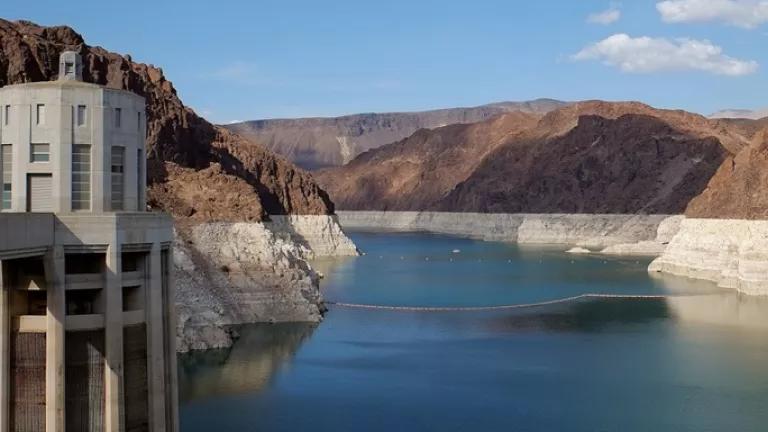How the Clean Water Act Can Combat Harmful Algal Blooms
NRDC's findings show public officials are not doing enough to test for and prevent nitrogen and phosphorus pollution.
NRDC just released two analyses that look at how state water pollution control and public health officials deal with one of the most significant causes of nitrogen and phosphorus pollution and one of the most important effects of nitrogen and phosphorus pollution. Both of these analyses have a lot to teach us about how the Clean Water Act works now (spoiler alert—for this pollution, not good) and how it ought to be implemented in the future.
The Problem: Nitrogen and Phosphorus Runoff Fuel Water Quality Problems
The first report is an important effort to track states’ access to, and efforts to make public, information about industrial livestock facilities, known in the Clean Water Act as “concentrated animal feeding operations,” or “CAFOs.” As my colleague Valerie Baron discusses, our report documents the numerous harms that livestock operations can inflict on nearby communities, and the resulting need for pollution control officials to have adequate information to properly regulate the facilities’ management of manure and the nitrogen and phosphorus it contains. Unfortunately, as we found, the available information about these operations is out of date, grossly incomplete, and highly variable from state to state These findings call out for a renewed effort to comprehensively understand—and then control—nutrient pollution from animal factories.
The second release is an overview of how states track and communicate the threats associated with events scientists refer to as “harmful algal blooms.” Algae are photosynthetic organisms that derive energy from the sun and grow wildly when fed by nutrients like nitrogen and phosphorus, leading to massive “blooms” of organisms. These blooms are fueled, in part, by fertilizer and manure runoff from farms and other animal facilities. In some cases, these blooms are just gross—they create a slimy muck that you don’t want to share the water with. In other cases, when the algae die, the decomposition process sucks oxygen from the water and causes water bodies to become “hypoxic”; the enormous annual Gulf of Mexico “Dead Zone” is an example of a hypoxic area. Finally, harmful algal blooms can be dangerous because they produce toxins that are harmful to animals and people. This last algae-related problem is the subject of the recent analysis, as my colleague Arohi Sharma describes.
A Major Solution: The Clean Water Act Can Slash Pollution that Causes Harmful Algal Blooms
Together, NRDC’s findings, along with our work in these areas over several decades, point to a common denominator: the public officials responsible for implementing and enforcing the Clean Water Act are not doing enough to test for and prevent nitrogen and phosphorus pollution. This post describes what effective enforcement of the Clean Water Act might look like.
Numeric Nutrient Standards: One of the foundations of pollution control under the Act is the establishment of state standards identifying levels of pollutants that, if exceeded, will endanger water quality such that a water body might not be safe for whatever “designated uses” a state has identified for the water. (Designated uses include things like fishing, swimming, and drinking water supply.) Numeric standards help permit writers establish discharge limits for facilities that release these pollutants and they also enable states to identify when water bodies need to be cleaned up.
Nearly two decades ago, EPA instructed states to develop numeric standards or else the agency would step in, but this proved to be an empty promise. EPA’s own Inspector General issued a report 10 years ago saying states were falling down on the job and urged EPA to issue standards itself. But when NRDC and our partners petitioned EPA to do just that and sued to get a ruling on our petition, EPA furiously fought for its ability to dodge this responsibility and—at least to date—has managed to defend its do-nothing approach in court. This irresponsibility has consequences: EPA acknowledges that only one state has a full set of numeric nutrient standards for all of its waters and expects that, in 2021, the vast majority of states will have no numeric standards or will have standards for just a smattering of waters.
EPA needs to act. The evidence is overwhelming that states either lack the political will or the technical capacity to establish these critically-needed numeric benchmarks.
Enhanced Discharge Limits for Nutrient Sources: The Clean Water Act charges EPA with establishing industry-specific limits on their pollution, which are typically based on the control technology used by better-performing facilities in the industry. The agency must update these limits for industries that have significant nutrient discharges but has failed to do so.
- Sewage treatment plants: Human waste contains nitrogen and phosphorus. The facilities that treat our sewage, however, are not subject to national discharge limits for those pollutants. In fact, when NRDC and our partners petitioned EPA to establish such limits, the agency balked. (Ironically, despite the widespread lack of numeric nutrient standards for water bodies discussed above, EPA claimed that the better way to handle nutrient pollution from sewage plants was to set case-by-case limits based on water body-specific standards.) Even worse, EPA plans to make it easier for wastewater plants to release partially-treated sewage during rainstorms. As 69 conservation groups told EPA, pursuing this rollback makes no sense given how little evidence the agency has that authorizing increased sewage blending will not cause harm.
- Livestock factories: As noted above and in NRDC’s report, CAFOs are poorly understood and even more poorly regulated today. NRDC and numerous organizations have been calling on EPA to strengthen the national regulations for many years. These facilities’ direct impacts on communities are reason enough for EPA to act, and the prevalence of harmful algal blooms makes that need even more acute.
- Meat processing plants: Slaughterhouses contribute to nutrient pollution and the vast majority of them are not subject to Clean Water Act limits on their discharges. Others must comply with outdated limits. A coalition of conservation groups have notified EPA of their intent to sue the agency for failing to modernize these pollution limits.
- Stormwater systems: Runoff from suburban and urban areas is typically routed straight to water bodies without any treatment. As my colleague Cori Bell explains, stormwater systems can be important sources of nutrient pollution; rainfall carries lawn fertilizer and other sources of nutrients (like nitrogen compounds deposited from the air) into rivers, streams, and other waterways. Although we know how best to handle polluted stormwater – by using green infrastructure to prevent runoff from reaching water bodies – EPA and state pollution control officials do not often require systems to implement these commonsense solutions.
Meaningful Control of Agricultural Runoff: The Clean Water Act exempts most discharges from normal farming operations from the Act’s permitting requirements, but it nevertheless provides significant tools for controlling such pollution. EPA and state officials must implement these requirements in a rigorous manner if we are to sufficiently rein in nutrient pollution to deal with our toxic algae crisis.
- Oversight of nonpoint source management programs: In 1987, in recognition of the importance of agricultural runoff and other so-called “nonpoint source” pollution, Congress adopted a grant program—contained in section 319 of the Clean Water Act—to fund projects to reduce that pollution. Projects are supposed to be carried out in accordance with a periodically-updated nonpoint management plan, formulated by states subject to EPA approval. States must demonstrate satisfactory progress on reducing pollution to be eligible for funding in subsequent years. According to the Government Accountability Office, EPA’s oversight of these programs, including their success in making meaningful progress, has been spotty, and the agency has failed to address a number of identified deficiencies. The agency should insist on accountability for project performance and on states making significant progress in reducing runoff pollution to impaired waterways as a condition of providing future funding.
- Strengthen requirements for addressing impaired waters: Agricultural pollution is the top known contributor to rivers’ and streams’ failure to meet applicable standards, and the number two known cause for lakes, ponds, and reservoirs. But when states develop cleanup targets for impaired waters (known in the wonky Clean Water Act world as “total maximum daily loads” or “TMDLs”), they do not reliably formulate implementation plans to achieve necessary reductions or include a strategy to adopt legally enforceable controls on agricultural pollution. In 2000, EPA adopted regulations to make TMDLs more robust, but they were withdrawn in response to attacks from agribusiness, among others. EPA should revisit that decision, especially given the experience with the Chesapeake Bay watershed; in that region, there are enforceable plans, and progress has been more pronounced.
- Enforce antidegradation requirements: States are required to protect clean waterways from becoming impaired. In order to do so, they are required to implement “all cost-effective and reasonable best management practices for nonpoint source control” when taking action that’ll worsen water quality. However, I’ve been unable to identify any instance in which this requirement has been enforced, even though EPA has the authority to reject discharge permits that don’t comply with the regulations. The agency should do so—it should object to proposed permits for new or expanded nutrient discharges unless and until the states demonstrate that they’ve put in place a suite of management practices on existing sources of agricultural runoff.
Stop the Assault on Clean Water Act Protections for Small Streams & Wetlands
As I’ve written about on several occasions, the Trump administration has launched a multi-pronged assault on protecting streams, wetlands, and other waters under the Clean Water Act. These features are enormously important for a variety of reasons; as relevant to this post, they filter nutrients out of polluted runoff. By trying to eliminate commonsense protections for these waters adopted in 2015 and planning to exclude millions of miles of streams and tens of millions of acres of wetlands (more than half of the country’s total) from the Clean Water Act, the administration threatens to make nutrient pollution and harmful algal blooms worse. It’s not too late to put the brakes on this reckless effort and the administration really ought to do so.




